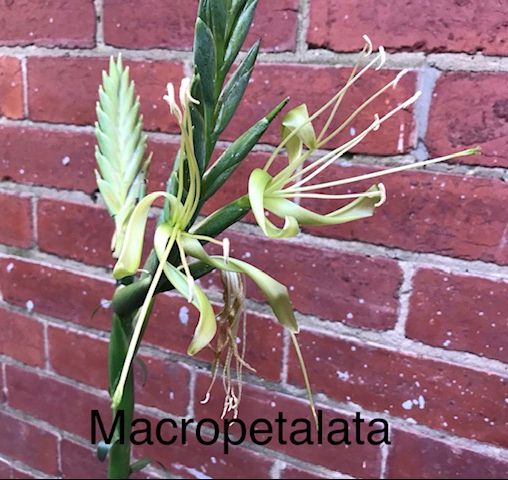
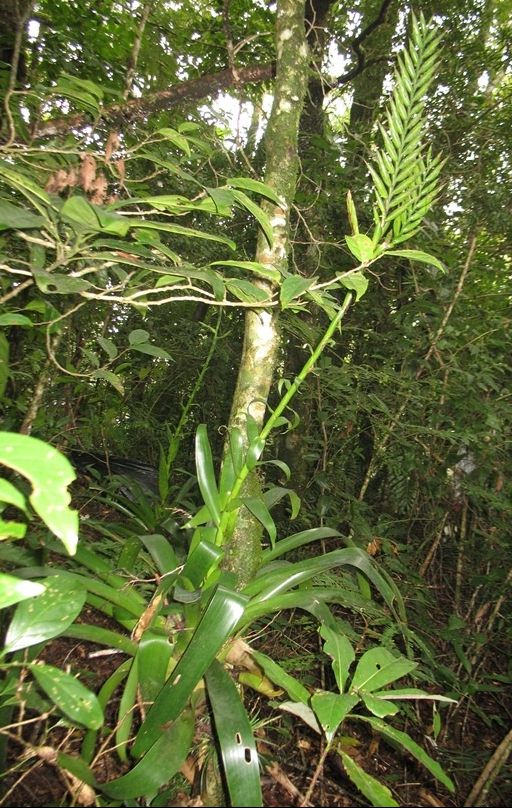
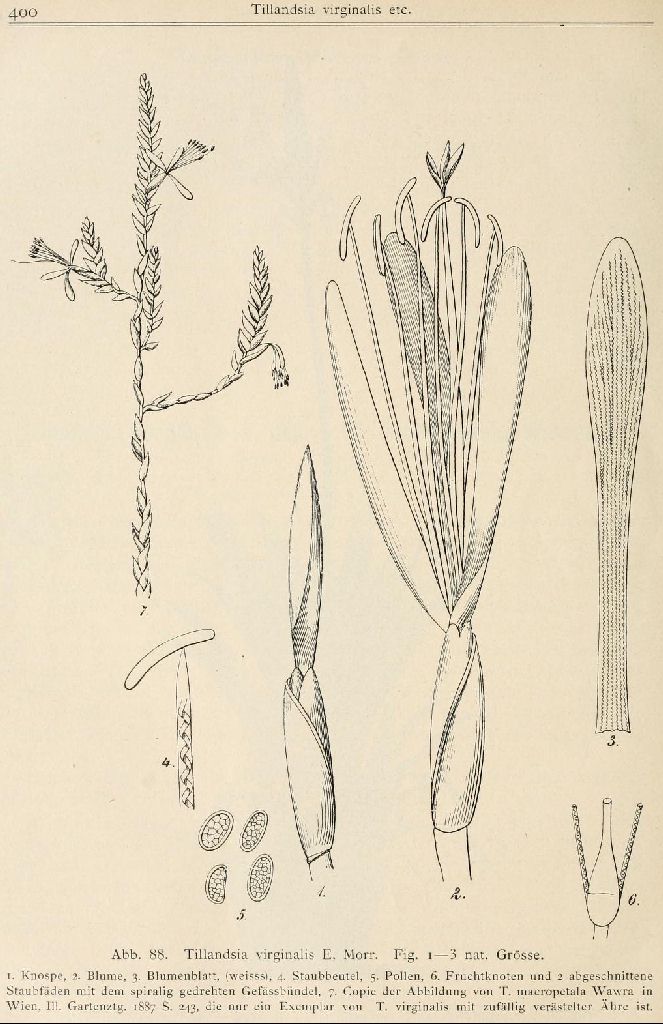
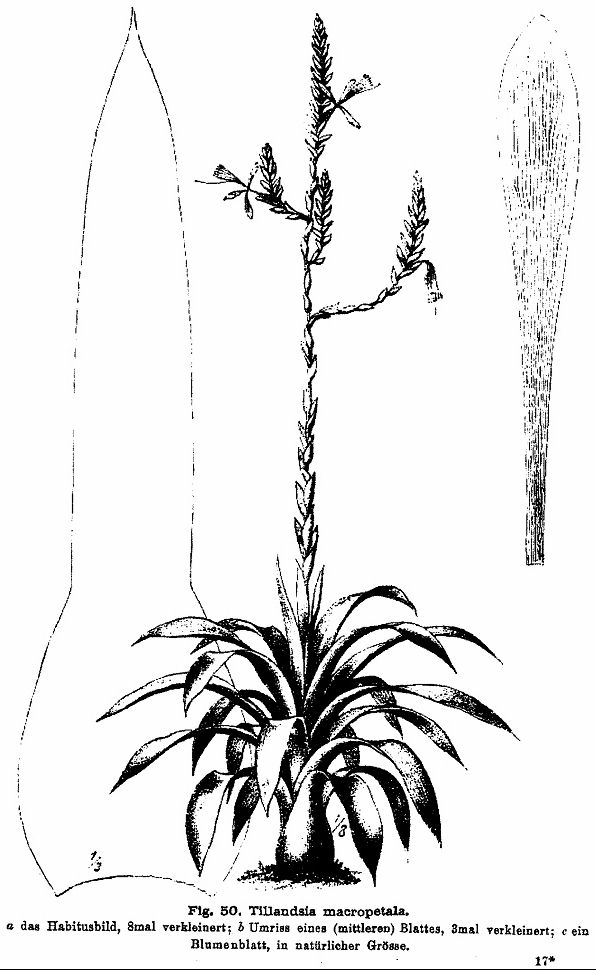

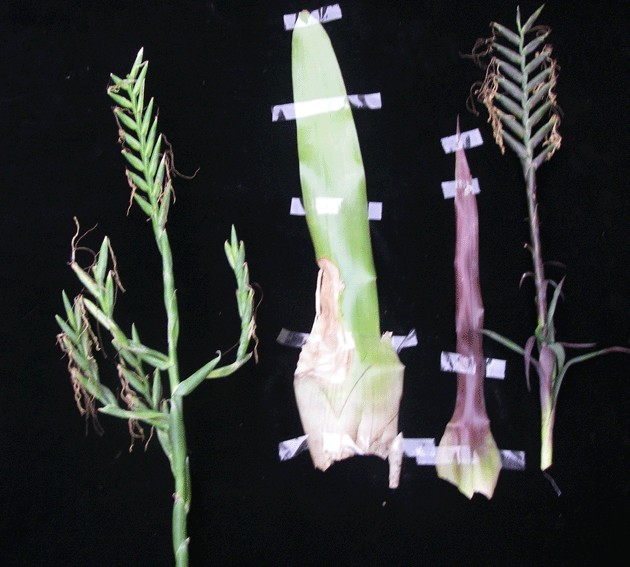
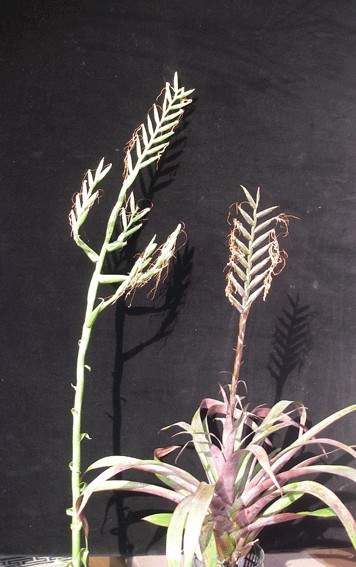

Pseudalcantarea macropetala (Wawra) Pinzón & Barfuss, comb. nov. Phytotaxa 279(1): 001-097. 2016
Basionym:—Tillandsia macropetala Wawra, Wiener Ill. Gart.-Zeitung 12: 241, fig. 50 (1887), Type:—Morren s.n. in Liège Hortus s.n. (holo W, lost; iso ?LG); Lectotype (designated by Krömer et al., 2012: 8):—Figure 50 in Wiener Ill. Gart.-Zeitung 12: 241 (1887); Epitype (designated here):—Krömer & Otto 2866 (epi UAMIZ; isoepi MEXU, SEL, XAL)
= Tillandsia viridiflora var. variegata P. Mitch., J. Bromeliad Soc. 21(3): 51, fig. (1971), nom. inval. {Art. 39.1, 40.1}
= Tillandsia viridiflora var. variegata Seaborn, J. Bromeliad Soc. 29(4): 182, fig. (1979), Type:—Seaborn s.n. (holo US)
Note:—The epitype designation for Tillandsia macropetala by Krömer et al. (2012) is further narrowed to a single specimen. Since four different herbaria are stated,the one herbarium (UAMIZ) is specified which is conserving the epitype and the other herbaria (MEXU, SEL, XAL) indicated, holding the duplicated specimens of the epitype {isoepitypes Rec 9C.1}.
Detail from T Kromer et al in Acta Bot Mex. 99: 1-20. 2012
Tillandsia macropetala Wawra, Wiener Ill. Gart.-Zeitung 12: 241-244, Fig. 50. 1887.
TYPE: E. Morren in Liege hortus s.n. (not located). Lectotype, here designated: Figure 50 in Wiener Illustrierte Garten-Zeitung 12. 1887 (Fig. 3).
Epitype, here designated: municipio de Soteapan, faldas del volcan Santa Marta, 18°19'N, 94°50' W, 1300 m, 19.VIII.2006, T. Kromer & E. Otto 2866 (MEXU, SEL, UAMIZ, XAL).
Rosulate stemless epiphytic or very rarely lithophytic herbs, flowering 1.3-1.75 m tall,with solitary tank rosettes to 1.2 m in diameter.
Leaves numerous;
sheaths brown to light brown on both surfaces, widely elliptic, 13-15 cm long, 8-8.5 cm wide, densely brown punctulate-lepidote on both surfaces;
blades green, paler beneath, strap shaped, 17-45 cm long, 3.5-7 cm wide at the base, punctulate-lepidote on both surfaces, acuminate, erect to ascending.
Inflorescence terminal, erect, compound, once branched, with 3 to 7 spikes, very rarely simple,
peduncle terete, 55-83 cm long, 5-8 mm in diameter;
peduncle bracts imbricate, green, foliaceous only the distal ones vaginiform; sheaths 3.5-4.2 cm long, blades 7-14 cm long;
spikes compressed, oblong, 9-23.5 cm long,3-6 cm wide, stipitate, stipes straight to slightly curved, 5-11 cm long, 3.5-5 cm in diameter;
primary bracts vaginiform, ovate-triangular, 5.5-7 cm long, 4.5-5.3 cm wide, acuminate;
floral bracts green, glaucous, widely elliptic, 3.3-4.3 cm long, 1.4-2.4 cm wide, imbricate but the rachis visible after anthesis, nervate, ecarinate, glabrous outside, brown punctulate-lepidote inside, margin erose, apex rounded to acute;
flowers distichous, erect, (5)15-20 per spike, actinomorphic, corolla helicoiform, subsessile;
sepals free, green, oblong, 3-3.4 cm long, 1.3-1.5 cm wide, nervate, ecarinate, glabrous outside, brown-punctulate lepidote inside, margin erose, apex rounded to acute;
petals light green, strap shaped, twisted, 10.7-12.3 cm long, 14-17 mm wide, rounded at the apex;
stamens subequal, filaments free, light green to white, filiform, 10.4-11.7 cm long, anthers green to green-whitish, linear, curved, 7.5-8 mm long;
ovary green, ovoid, 9-12 mm long, ca. 6 mm in diameter, style green, filiform, 10.7-11.4 cm long, stigma green.
Capsule green, fusiform, rostrate, 5.3-6 cm long, ca. 1 cm in diameter; seeds dark brown, fusiform, ca. 4.5 mm long, with a white coma ca. 3 cm long.
Notes
During the course of two botanical field trips through the state of Oaxaca in the years 2005 and 2006, the late Jurgen Lautner, Renate Ehlers and collaborators collected several plants of a species of Tillandsia L. in the Sierra Mixe, which were provisionally identified as T. viridiflora (Beer) Baker. Additionally in 2006, Thorsten.
Kromer and Elisabeth Otto collected one specimen of the same Tillandsia species on the slopes of the Santa Marta volcano, located in the southeastern region of Los Tuxtlas, in the state of Veracruz. In order to confirm the identity of these plants, we studied cultivated and herbarium material, and also the related taxonomic literature. After a careful study of literature relating to these plants (Baker, 1889; Smith & Downs, 1977; Weber, 1984; Utley & Burt-Utley, 1994; Beaman & Judd, 1996), an analysis of the original descriptions and plates of the names related to Tillandsia viridiflora and its putative synonyms T. macropetala Wawra, T. orizabenzis Baker, T. longiflora Sesse & Moc. and T. billbergiae (Lem) Baker (Schlechtendal, 1845; Beer, 1856; Lemaire, 1869; Morren, 1873,1880; Wawra, 1887; Baker, 1888; Sesse & Mocino, 1887, 1894; Mez, 1935), and study of all relevant specimens and types deposited in the main Mexican (CHAP, ENCB, FCME, IBUG, IEB, MEXU, OAX, UAMIZ, XAL) and foreign (GH, K, LL, MA, MICH, MO, OXF, P, SEL, TEX, UC, US, WU) herbaria, we come to the conclusion that the plants collected at both localities mentioned above, and also some herbarium material formerly identified as T. viridiflora, T. grandis and/or T. heterophylla E. Morren must be assigned to T. macropetala, a name previously considered by some authors as a taxonomic synonym of T. grandis (Mez, 1935) or T. viridiflora (Smith & Downs, 1977; Espejo & Lopez-Ferrari, 1994; Espejo et al., 2004). We believe that each of these three species constitutes a phenetically distinctive entity, following a morphological-taxonomic species concept. However, besides their differences in habit and the appearance of leaves and peduncle bracts, especially obvious in living plants (Fig. 1, 2 C-D), T. macropetala seems most closely related to T. viridiflora, as both species are more similar in size and occur epiphytic, whereas T. grandis is much bigger and grows lithophytic (Fig. 2A; Table l).
With the reestablishment of Tillandsia macropetala as a valid species, the number of taxa of the T. viridiflora complex present in Mexico reaches three. Additionally, because of its close morphological similarity, this species complex probably includes the Caribbean T. paniculata (L) L. and T. baliophylla Harms. Following the classification of Smith & Downs (L977), all these belong to Tillandsia subgenus Pseudoalcantarea Mez. However, Beaman & Judd (1996) suggested that this subgenus is paraphyletic, and transferred T. grandis and T. paniculata to subgenus Tillandsia. Furthermore, Barfuss et al. (2005) in a phylogenetic analysis of subfamily Tillandsioideae suggested that T. baliophylla and T. viridiflora also do not form a clade. Therefore, although we have clarified species limits in this complex, it is clear that much more phylogenetic work is necessary before we can be confident as to their phylogenetic relationships. We include an identification key for the three Mexican taxa, their correct names, complete synonymy, descriptions, and a distribution map. (Ed: See viridiflora page for key and map.)
Smith & Downs (1977) cited Vriesea macropetala hort. (Rev. Hort. 69:336. 1897) as synonym of Tillandsia viridiflora. However, this name is only mentioned in a publication of the Societe National d'Horticulture de France without any description or mention of a basionym. Probably, Smith & Downs (1977) supposed that the name could be a transfer from Tillandsia macropetala Wawra, because of the same epithet, although we think that there is no clear evidence and it might be a nomen nudum.
Tillandsia macropetala Wawra, Wiener III. Gart. 12: 241, Fig. 50. 1887. Type. Vienna Hortus ex E. Morren s n (n v). Identified by description and illustration.
Tillandsia macropetala Von Dr. H. Ritter Wawra von Fernsee.
Translated by Butcher:
A magnificent plant 1½ metres high, formed by a rosette of leaves, around the base of the shaft virtually 1 metre in diameter; its massive of wide pale red sheaths unite in an oval bulb; its lanceolate leaf blades spreading in a dainty bow, as you look downwards; they taper to a fine tip, a lively green, matt, both sides about the same colour and with faint darker stains and markings. The innermost leaves erect, are smaller and narrower, and merge into the scape bracts above.
The Inflorescence is very long and, very poorly branched Panicle; the Panicle scape is strictly erect, as thick as your thumb and covered over with bracts; the lowermost bracts are leaf-like, the upper ones quickly becoming shorter to about 4 cm long and oblong, keeps the colour of the leaves until the top which is brownish on the outside; they nestles narrowly on the scape, however the acuminate tip is spreading giving the stem a quite rough look. The bracts are very dense at the lower half and imbricate, then they move apart more, so that the scape remains uncovered to the node, at the same time they become thinner and lanceolate; the uppermost are appressed to the stem.
The branches, with our plant three at number, are almost at right angles where they branch off, bending soon upward, shorter than the top spike, always simple and with a primary bract similar to the scape bracts but somewhat wider, and solidly appressed to the branch.
The flowers are densely distichously arranged on the branches, but clearly move apart after anthesis. The floral bracts are similar to the scape bracts, only they are rounder and a little bigger than these; the lowermost are sterile. The flowers are sessile, which with the floral bract are joined on a short stalk.
The calyx is a rounded stem and exactly as long as the bract but appears about as long as the exserted stem. Sepals are pale green, only at the outer tip are some brownish and hardly marked.
The pale yellow petals overhang (to my knowledge) those of all other Tillandsias and Vrieseas, they become 12 cm long; the lower ones are smaller, in the calyx half they are very narrow and the edges are imbricate, and form with the sepals a spiralling tube; the upper larger half is similarly wider so that they become fully 2cm wide below the rounded off tip. The petals are far apart and after anthesis hang laxly downwards; they are delicate and, (in subdued light) many nerved the nerves run parallel, bending downwards towards and disappearing near the petal edge, without anastomosis. Nectaries missing at the base.
The filaments straight, prominent, quite free, and about 2 cm longer than the corolla. The anthers are long, very narrow some over 1cm, (pollen gold-yellow), blunt at both ends, attached in its lower third, then split; lying near the fold.
The oblong smooth, with a slimy mass of outercoating Ovary, tapering into the threadlike style above. This is stronger than the filaments, and the tips are bent downwards, blunt triangular and exceeding the filament by about 2cm, therefore 16 cm long. The leaflike wide stigma lobes are lanceolate, blunt, green and spiral. The linear placenta have many rows, narrow short stemmed, of short stringed seeds.
Habitat: Mexico.
The illustration of this plant (larger in real life), with a leaf and a flower came to me from Liege from my unforgettable friend, the highly regarded botanical and particularly Bromeliaceae expert Professor Morren, a few days after his passing away. Morren seems to have shown great interest in the solution to the problem as to whether this was a new species because of its unique vegetative organs; it was not for him to experience the development of the flower. The expectation of Morren's was amply justified. The plant proved to be a new species, which is mainly based on the very long petals from the other Tillandsias (and Vrieseas). But it shows another peculiarity; our plant has completely the habit of a Vriesea but lacks the honey-scales at the base of the petals. The existence of these scales in Vriesea forms the only decisive, because the flower is different to Tillandsia; for the time being I believe this is a new species and name it Tillandsia macropetala because of its very long petals, after deciding to leave the proof as to whether it was a Vriesea or Tillandsia until later. I can only say that so far I cannot decide categorically that honey-scales constitute a Vriesea. Bentham and Hoocker (gene.) admittedly put no big weight on the same and unify both genera under Tillandsia. The entirely different look of that to Vriesea does not appear to justify such an amalgamation in the manner paid to Tillandsia without dividing a natural group. It remains to be seen whether we look for a new difference, whether in the flower or fruit, to take notice of the vegetative organs, incidentally where I had very little material to work with - the examination could be planned only on one single, wilted flower - that maybe tiny scales are the answer.